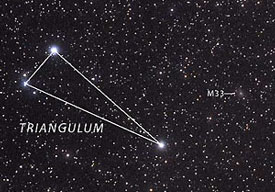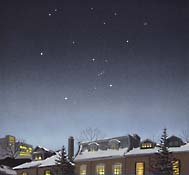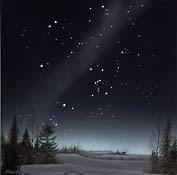
Akira Fujii
How dark is your sky? The relationship between light pollution and astronomy is a concern amateurs and professional astronomers alike. Are your skies dark enough? A precise answer to this question is useful for comparing observing sites and, more important, for determining whether a site is dark enough to let you push your eyes, telescope, or camera to their theoretical limits. Likewise, you need accurate criteria for judging sky conditions when documenting unusual or borderline observations, such as an extremely long comet tail, a faint aurora, or subtle features in galaxies.
Light Pollution and Astronomy
On Internet bulletin boards and newsgroups I see many postings from beginners (and sometimes more experienced observers) wondering how to evaluate the quality of their skies with a keen interest in light pollution and astronomy. Unfortunately, most of today's stargazers have never observed under a truly dark sky, so they lack a frame of reference for gauging local conditions. Many describe observations made at "very dark" sites, but from the descriptions it's clear that the sky must have been only moderately dark. Most amateurs today cannot get to a truly dark location within reasonable driving distance. Thus, upon finding a semirural observing site where stars of magnitude 6.0 to 6.3 are marginally apparent to the unaided eye, they believe they have located an observing Nirvana!
Thirty years ago one could find truly dark skies within an hour's drive of major population centers. Today you often need to travel 150 miles or more. In my own observing career I have watched the extent to which ever-growing light pollution has sullied the heavens. In years long past I witnessed nearly pristine skies from parts of the highly urbanized northeastern United States. This is no longer possible.
Limiting Magnitude Isn't Enough
Amateur astronomers usually judge their skies by noting the magnitude of the faintest star visible to the naked eye. However, naked-eye limiting magnitude (NELM) is a poor criterion. It depends too much on a person's visual acuity (sharpness of eyesight), as well as on the time and effort expended to see the faintest possible stars. One person's "5.5-magnitude sky" is another's "6.3-magnitude sky." Moreover, deep-sky observers need to assess the visibility of both stellar and nonstellar objects. A modest amount of light pollution degrades diffuse objects such as comets, nebulae, and galaxies far more than stars.
To help observers judge the true darkness of a site, I have created a nine-level scale. It is based on nearly 50 years of observing experience. I hope it will prove both enlightening and useful to observers — though it may stun or even horrify some! Should it come into wide use, it would provide a consistent standard for comparing observations with light pollution. Researchers would also be better able to assess the plausibility of an unusual or marginal observation. All around, it could be a boon to those of us who regularly scan the heavens.
How Dark Is It? Rate Your Skies

The same constellation panorama in an urban, Class 8 or 9 sky.
John Bianchi
Class 1: Excellent Dark-sky Site
To the unaided eye the limiting magnitude is 7.6 to 8.0 (with effort), though the presence of Jupiter or Venus in the sky seems to degrade dark adaptation. The zodiacal light, gegenschein, and zodiacal band are all visible — the zodiacal light to a striking degree, and the zodiacal band spans the entire sky. The galaxy M33 is an obvious naked-eye object even with direct vision. The Scorpius and Sagittarius regions of the Milky Way cast obvious diffuse shadows on the ground. Airglow, a very faint, naturally occurring glow most evident within about 15° of the horizon, is readily apparent.
With a 32-centimeter (12½-inch) scope, stars to magnitude 17.5 can be detected with effort, while a 50-cm (20-inch) instrument used with moderate magnification will reach 19th magnitude. If you are observing on a grass-covered field bordered by trees, your telescope, companions, and vehicle are almost totally invisible. This is an observer's Nirvana!
Class 2: Typical Truly Dark Site
Airglow may be weakly apparent along the horizon. M33 is rather easily seen with direct vision. The summer Milky Way is highly structured to the unaided eye, and its brightest parts look like veined marble when viewed with ordinary binoculars. The zodiacal light is still bright enough to cast weak shadows just before dawn and after dusk, and its color can be seen as distinctly yellowish when compared with the blue-white of the Milky Way. Any clouds in the sky are visible only as dark holes or voids in the starry background. You can see your telescope and surroundings only vaguely, except where they project against the sky. Many of the Messier globular clusters are distinct naked-eye objects. The limiting naked-eye magnitude is as faint as 7.1 to 7.5, while a 32-cm telescope reaches to magnitude 16 or 17.
Class 3: Rural Sky
Some indication of light pollution is evident along the horizon. Clouds may appear faintly illuminated in the brightest parts of the sky near the horizon but are dark overhead. The Milky Way still appears complex, and globular clusters such as M4, M5, M15, and M22 are all distinct naked-eye objects. M33 is easy to see with averted vision. The zodiacal light is striking in spring and autumn (when it extends 60° above the horizon after dusk and before dawn) and its color is at least weakly indicated. Your telescope is vaguely apparent at a distance of 20 or 30 feet. The naked-eye limiting magnitude is 6.6 to 7.0, and a 32-cm reflector will reach to 16th magnitude.
Class 4: Rural/Suburban Transition
Winter constellations in a suburban or rural-suburban transition sky, with the winter Milky Way visible but not dramatically so. Such a sky, fairly good by many people's standards, might rate 4 or 5 on Bortle's scale. Many fainter stars than are depicted here would be visible with close scrutiny.

Fairly obvious light-pollution domes are apparent over population centers in several directions. The zodiacal light is clearly evident but doesn't even extend halfway to the zenith at the beginning or end of twilight. The Milky Way well above the horizon is still impressive but lacks all but the most obvious structure. M33 is a difficult averted-vision object and is detectable only when at an altitude higher than 50°. Clouds in the direction of light-pollution sources are illuminated but only slightly so, and are still dark overhead. You can make out your telescope rather clearly at a distance. The maximum naked-eye limiting magnitude is 6.1 to 6.5, and a 32-cm reflector used with moderate magnification will reveal stars of magnitude 15.5.
Class 5: Suburban Sky
Only hints of the zodiacal light are seen on the best spring and autumn nights. The Milky Way is very weak or invisible near the horizon and looks rather washed out overhead. Light sources are evident in most if not all directions. Over most or all of the sky, clouds are quite noticeably brighter than the sky itself. The naked-eye limit is around 5.6 to 6.0, and a 32-cm reflector will reach about magnitude 14.5 to 15.
Class 6: Bright Suburban Sky
No trace of the zodiacal light can be seen, even on the best nights. Any indications of the Milky Way are apparent only toward the zenith. The sky within 35° of the horizon glows grayish white. Clouds anywhere in the sky appear fairly bright. You have no trouble seeing eyepieces and telescope accessories on an observing table. M33 is impossible to see without binoculars, and M31 is only modestly apparent to the unaided eye. The naked-eye limit is about 5.5, and a 32-cm telescope used at moderate powers will show stars at magnitude 14.0 to 14.5.
Class 7: Suburban/Urban Transition
The entire sky background has a vague, grayish white hue. Strong light sources are evident in all directions. The Milky Way is totally invisible or nearly so. M44 or M31 may be glimpsed with the unaided eye but are very indistinct. Clouds are brilliantly lit. Even in moderate-size telescopes, the brightest Messier objects are pale ghosts of their true selves. The naked-eye limiting magnitude is 5.0 if you really try, and a 32-cm reflector will barely reach 14th magnitude.
Class 8: City sky
The sky glows whitish gray or orangish, and you can read newspaper headlines without difficulty. M31 and M44 may be barely glimpsed by an experienced observer on good nights, and only the bright Messier objects are detectable with a modest-size telescope. Some of the stars making up the familiar constellation patterns are difficult to see or are absent entirely. The naked eye can pick out stars down to magnitude 4.5 at best, if you know just where to look, and the stellar limit for a 32-cm reflector is little better than magnitude 13.
Class 9: Inner-city Sky
The entire sky is brightly lit, even at the zenith. Many stars making up familiar constellation figures are invisible, and dim constellations such as Cancer and Pisces are not seen at all. Aside from perhaps the Pleiades, no Messier objects are visible to the unaided eye. The only celestial objects that really provide pleasing telescopic views are the Moon, the planets, and a few of the brightest star clusters (if you can find them). The naked-eye limiting magnitude is 4.0 or less.
Editors' note: This article on light pollution and astronomy appeared in the February 2001 issue of Sky & Telescope.
 2
2









Comments
You must be logged in to post a comment.